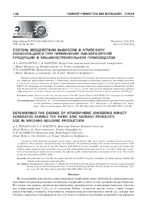| dc.contributor.author | Панасюгин, А. С. | ru |
| dc.contributor.author | Марцева, С. В. | ru |
| dc.contributor.author | Машерова, Н. П. | ru |
| dc.coverage.spatial | Минск | ru |
| dc.date.accessioned | 2024-06-13T09:48:45Z | |
| dc.date.available | 2024-06-13T09:48:45Z | |
| dc.date.issued | 2024 | |
| dc.identifier.citation | Панасюгин, А. С. Степень воздействия выбросов в атмосферу, образующихся при применении лакокрасочной продукции в машиностроительном производстве = Determining the degree of atmospheric emissions impact generated during the paint and varnish products use in machine-building production / А. С. Панасюгин, С. В. Марцева, Н. П. Машерова // Литье и металлургия. – 2024. – № 2. – С. 158-166. | ru |
| dc.identifier.uri | https://rep.bntu.by/handle/data/145156 | |
| dc.description.abstract | Проведен анализ образования паров органических растворителей, которые представлены уайт-спиритом, кетонами, спиртами, производными бензола, 1,4‑диоксаном, этилцеллозольвом и окрасочным аэрозолем. Вещества относятся к 3‑му и 4‑му классам опасности. В процессе производства использовали базовую краску Uno HD, краску Diamont R-M BASF P+E, покровный лак Standoflex 2k autolak и однокомпонентную шпатлевку-порозаполнитель Standox fine 1k-body. Расход материалов cоставлял соответственно 6,3; 2,7; 1,8 и 3,7 т/год. При расчете выбросов окрасочного аэрозоля эффективность очистных сооружений принималась равной 52 %. Размер экологического налога составил 2619,93 руб. | ru |
| dc.language.iso | ru | ru |
| dc.publisher | БНТУ | ru |
| dc.title | Степень воздействия выбросов в атмосферу, образующихся при применении лакокрасочной продукции в машиностроительном производстве | ru |
| dc.title.alternative | Determining the degree of atmospheric emissions impact generated during the paint and varnish products use in machine-building production | ru |
| dc.type | Article | ru |
| dc.identifier.doi | 10.21122/1683-6065-2024-2-158-166 | |
| local.description.annotation | An analysis of the formation of organic solvent vapors, represented by white spirit, ketones, alcohols, benzene derivatives, 1,4‑dioxane, ethyl cellosolve, and paint aerosol, was conducted. The substances belong to the 3rd and 4th hazard classes. In the production process, the base paint Uno HD, Diamont R-M BASF P+E paint, Standoflex 2k autolak topcoat, and Standox fine 1k-body single-component putty-pore filler were used. The consumption of materials was 6.3, 2.7, 1.8, and 3.7 tons/year, respectively. In calculating the paint aerosol emissions, the efficiency of the treatment facilities was assumed to be 52 %. The environmental tax amounted to 2,619.93 rubles. | ru |

